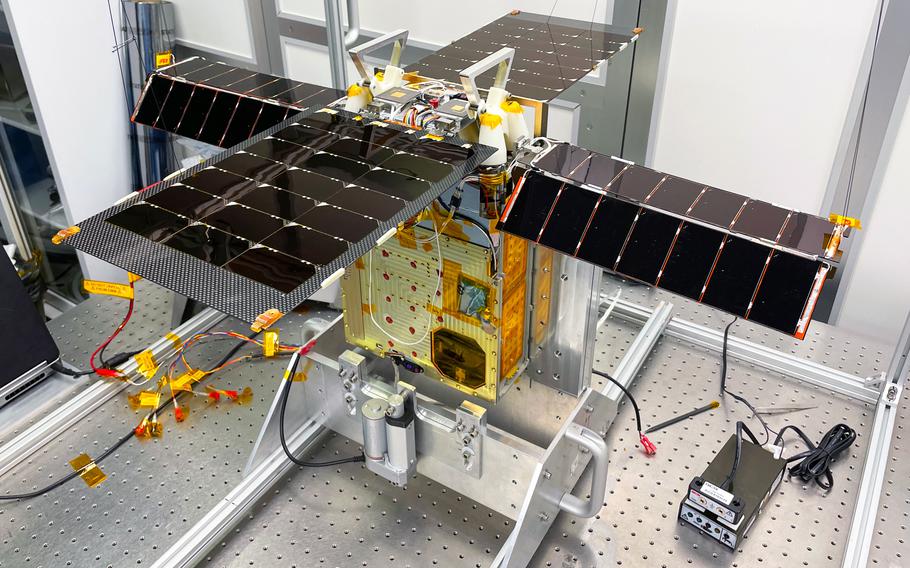
NASA’s Lunar Flashlight satellite that was supposed to take images of the moon’s ice deposits couldn’t overcome engine issues after launch, and the mission has officially ended. (NASA/JPL-Caltech)
(Tribune News Service) — NASA’s little satellite that was supposed to take images of the moon’s ice deposits couldn’t overcome engine issues after launch, and the mission has officially ended.
The Lunar Flashlight took off from Cape Canaveral Space Force Station as one of two moonbound payloads on board a SpaceX Falcon 9 on Dec. 11, 2022, along with the private HAKUTO-R Mission lunar lander from Japanese company ispace, with both aiming to take an energy-saving four-month trip to the moon.
While ispace’s lander suffered its own demise after a hard impact on its landing attempt, it came much closer to achieving its goals than the Lunar Flashlight ever did.
The small NASA satellite saw less-than-expected thrust from three of its four engines soon after launch, according to NASA’s Jet Propulsion Laboratory. Despite efforts to work around the propulsion headaches, NASA could not get the satellite into any sort of orbit for it to perform its intended mission of using a reflectometer with four near-infrared lasers to search for surface ice in the permanently shadowed craters of the moon’s south pole.
NASA is interested in ice as both a fuel and air source to support a future lunar base. The planned Artemis III mission that could fly in 2025 is looking to return astronauts to the moon for the first time since 1972 with several south pole landing sites being considered.
The plan was for the satellite to have entered a near-rectilinear halo orbit that would have brought it within 9 miles of the moon’s south pole at its closest approach once a week. It’s the same orbit planned for NASA’s Gateway lunar space station as part of the Artemis program, an energy-saving orbit that uses both the Earth and moon gravity to keep it in place.
When the engines didn’t perform as intended, the JPL team tried to at least keep the Lunar Flashlight in a distant Earth orbit that would have let it make monthly flybys of the moon.
All of those efforts proved fruitless, though, and now the satellite will make one final close pass of Earth this week before heading off into deep space to orbit the sun, according to the JPL.
While its ice-hunting goals were not realized, the satellite did fulfill some technology demonstrations including the use for the first time beyond Earth’s orbit of the “green” fuel known as ASCENT (Advanced Spacecraft Energetic Non-Toxic) for propulsion developed by the Air Force Research Lab. It’s less toxic to handle than hydrazine, which is used for most in-space maneuvering, and also more efficient.
NASA stated it believed the propulsion failure was because of likely debris buildup in the thruster fuel lines, potentially because of how the fuel feed system was manufactured, with metal powder or shavings in the mix as the ultimate culprit.
Other mission successes, though, according to NASA were the first use of an energy-saving flight computer developed by JPL called Sphinx designed to endure deep-space radiation and a radio system called Iris with a new level of precision navigation capability. And while it wasn’t able to aim its ice-detecting reflectometer at its lunar target, NASA officials said it did operate as expected once in space, and likely would have been able to complete its mission had it made it to the moon.
“Technology demonstrations are, by their nature, higher risk and high reward, and they’re essential for NASA to test and learn,” said NASA’s Christopher Baker with the Space Technology Mission Directorate in a press release. “Lunar Flashlight was highly successful from the standpoint of being a test bed for new systems that had never flown in space before. Those systems, and the lessons Lunar Flashlight taught us, will be used for future missions.”
©2023 Orlando Sentinel.
Visit orlandosentinel.com.
Distributed by Tribune Content Agency, LLC.